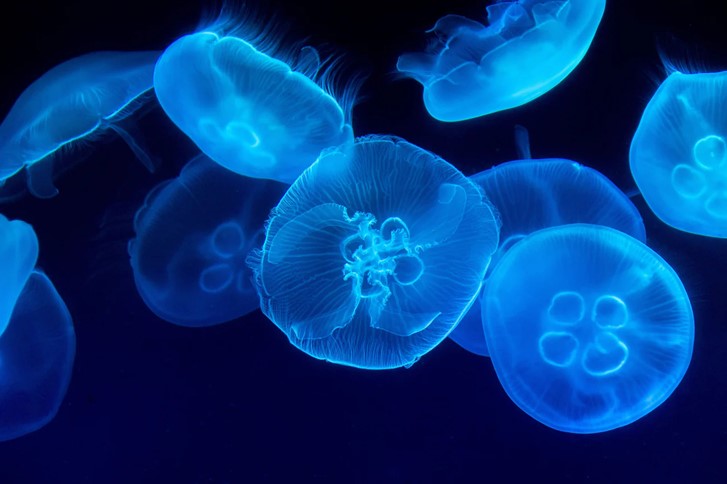September 29, 2023
Exploring the Enigmatic World of Jellyfish
Mysteries of the Deep: Exploring the Enigmatic World of Jellyfish
Beneath the shimmering surface of our planet's oceans lies a world of wonder and mystery inhabited by creatures that defy imagination. Among these enchanting denizens of the deep, one group stands out for its otherworldly appearance and mesmerising beauty: the jellyfish. These ethereal beings have fascinated and perplexed scientists and nature enthusiasts for centuries. In this article, we will delve into the captivating world of jellyfish, exploring their unique characteristics, their vital role in marine ecosystems, and the ongoing scientific discoveries that continue unlocking these enigmatic creatures' secrets.
A Diverse Cast of Characters
Jellyfish, also known as medusae, belong to the phylum Cnidaria, which includes other aquatic creatures like corals and sea anemones. They are an incredibly diverse group, with over 2,000 known species, ranging from small, transparent organisms to much larger and more complex creatures. Despite their name, jellyfish aren't fish – they are more closely related to corals and sea anemones than true fish.
One of the defining features of jellyfish is their translucent, gelatinous bodies, which often resemble floating umbrellas or bells. These delicate bodies house a simple yet elegant organization of tissues. They have a saucer-shaped, or bell-shaped, body with tentacles hanging below. The bell pulsates rhythmically, allowing them to move through the water gracefully. Most jellyfish have specialised stinging cells, called cnidocytes, that they use to capture prey.
Bioluminescence, the ability to produce light, is another intriguing characteristic of some jellyfish species. They light up the dark ocean depths with a mesmerising display of colours, serving as a defence mechanism and a tool for attracting prey.
A Vital Role in Marine Ecosystems
Jellyfish play an essential role in marine ecosystems despite their delicate appearance. They are opportunistic predators, feeding on various planktonic organisms, small fish, and even other jellyfish. This helps to control the population of these organisms, preventing potential imbalances in the marine food web.
Furthermore, the jellyfish life cycle is unique. They go through several stages, including a polyp stage that attaches to the ocean floor and a free-swimming medusa stage. This reproductive strategy allows them to adapt to changing environmental conditions and makes them resilient in the face of disturbances.
The Jellyfish Sting
One of the aspects of jellyfish that garners the most attention from beachgoers and swimmers is their sting. Not all jellyfish can deliver painful stings, but some, like the infamous Portuguese man-of-war and the box jellyfish, have venomous tentacles that can cause intense discomfort, pain, and even life-threatening reactions in humans.
Understanding how to treat jellyfish stings and taking precautions when swimming in jellyfish-prone areas is crucial for anyone who enjoys the ocean. Vinegar is often recommended to neutralise the toxins in the tentacles, and seeking immediate medical attention is essential in severe cases.
The Beauty of Bioluminescence
While some jellyfish are feared for their stings, others are celebrated for their captivating bioluminescent displays. Many species of jellyfish have the remarkable ability to emit light, creating a breathtaking underwater spectacle. This bioluminescence is produced by specialized cells called photophores, which emit a soft, blue-green light when disturbed or threatened.
Scientists are still unravelling the mysteries behind this bioluminescence, including its purpose and the precise mechanisms that control it. Some theories suggest that it may serve as a defence mechanism to startle or deter potential predators. In contrast, others propose that it helps attract prey or even plays a role in communication between individuals.
Conservation and the Changing Ocean
Jellyfish populations are experiencing shifts in response to changing ocean conditions, including rising sea temperatures and increased acidity due to climate change. These changes can increase jellyfish blooms and have significant ecological and economic impacts.
Understanding the complex relationships between jellyfish and their environment is crucial for managing and conserving marine ecosystems. Scientists are studying the factors that influence jellyfish populations and how they interact with other species to predict better and mitigate the effects of jellyfish blooms.
With their enchanting beauty and enigmatic qualities, Jellyfish continue to inspire wonder and curiosity in those who explore the oceans. From their mesmerising bioluminescent displays to their vital role in marine ecosystems, these creatures remind us of life's incredible diversity and complexity beneath the wave.


